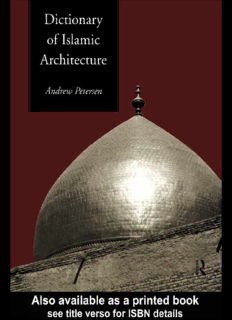Table Of ContentDICTIONARY OF
ISLAMIC ARCHITECTURE
DICTIONARY OF
ISLAMIC ARCHITECTURE
Andrew Petersen
London and New York
First published 1996
by Routledge
11 New Fetter Lane, London EC4P 4EE
This edition published in the Taylor & Francis e-Library, 2002.
Simultaneously published in the USA and Canada
by Routledge
29 West 35th Street, New York, NY 10001
First published in paperback 1999
© 1996 Andrew Petersen
All rights reserved. No part of this book may be reprinted or reproduced or utilized in
any form or by any electronic, mechanical, or other means, now known or hereafter
invented, including photocopying and recording, or in any information storage or
retrieval system, without permission in writing from the publishers.
British Library Cataloguing in Publication Data
A catalogue record for this book is available from the British Library
Library of Congress Cataloging in Publication Data
A catalogue record for this book is available from the Library of Congress
ISBN 0-415-06084-2 (hbk)
ISBN 0-415-21332-0 (pbk)
ISBN 0-203-20387-9 Master e-book ISBN
ISBN 0-203-20390-9 (Glassbook Format)
Contents
Preface vii
Acknowledgements ix
Entries 1
Appendix
The Mediterranean World showing principal historic cities and sites 320
The Middle East and Central Asia showing principal historic cities and sites 321
Dedication
This book is dedicated to my friend Jamie Cameron (1962–95) historian of James V of Scotland.
Preface
In one of the quarters of the city is the Muhammadan town, where the Muslims
have their cathedral, mosque, hospice and bazar. They have also a qadi and a
shaykh, for in every one of the cities of China there must always be a shaykh al-
Islam, to whom all matters concerning Muslims are referred.
Ibn Battuta, Travels in Asia and Africa 1325–1354, Routledge & Kegan Paul, 1929
Abu Abdallah Mahammad of Tangier, also known monuments. In order to aid the reader’s appreciation
as Ibn Battuta, is the most famous of the Arab of this relationship, vernacular architecture has been
travellers. His journeys started with a pilgrimage included in regional summaries, which also discuss
(hajj) to Mecca and afterwards he always tried to the geographical and cultural character of an area.
travel within a Muslim context whether he was in As a balance to the regional approach there are also
Timbuktu or China. What is notable about these historical accounts dealing with particular dynasties
accounts is that they deal with Muslim communities or historic styles.
which are remote from the western stereotype of The encyclopedic nature of this work has meant
Muslim society. For example most general works on that there is little room for theoretical discussions of
Islamic architecture tend to confine themselves to aesthetics or meaning. This is not because these are
the Middle East and North Africa, neglect-ing the unimportant considerations but because these are
centuries old Islamic heritage of South-East Asia, issues best discussed in a different, more selec-tive
India, East and West Africa. It is an aim of this book format. The main purpose of this book is to provide
to include as many as possible of these less well basic information which includes defini-tions of
known Muslim cultures whose populations now architectural terms, descriptions of specific
outnumber those of the central Islamic lands. monuments and summaries of regional and historic
As a corollary to this approach there has been an groups. Attached to each entry there is a short list of
attempt to include vernacular architecture rather books for further reading which refers the user to
than dealing exclusively with well known the principal works on the subject. It is hoped that
monumental architecture. As well as being important the information provided will enable the reader to
in its own right vernacular architecture provides an gain some appreciation of the diversity and genius
architectural context for the more famous of Muslim culture.
Acknowledgements
First, I must thank my parents who have enabled me to Archaeology in Iraq, the British Institute at Amman
pursue my interest in this subject. Gwendolyn Leick gave for Archaeology and History, the British Institute in
me the idea for the book in the first place and subsequently Eastern Africa, the International Merv Project, Dr
encouraged me in the long process of writing. Julian Reade and the Turkish Government.
The research that I undertook for the book was Preparation of the manuscript and drawings was
of two kinds—library based and field work. The helped by a number of people including Heather
library research was carried out in a number of Nixon, Charles Craske, Crispian Pickles, David
institutions in Europe and the Middle East and I Myres and Kate Cheyne. Photographs were provided
would like to thank everyone who helped me with by a number of people and institutions, in particular
references or information, in particular: Michael I would like to thank Kerry Abbott, Pat and Charles
Given, Tony Grey, StJohn Simpson, Benjamin Pickles, Aithie, Susan Bailey, Rebecca Foote, Cherry Pickles
Mark Horton, Alistair Northedge, Matt Thompson and James Allan. Here I would also like to express
and Jeremy Johns. The field research was usually my thanks to Mark Barragry and Seth Denbo both
carried out as an incidental part of other projects. of Routledge for their enthusiasm and patience.
Several individuals and institutions have been Finally, I would like to express my gratitude to
particularly helpful; these are: the British School of my wife Heather Nixon who tolerated and helped
Archaeology in Jerusalem, the British School of with this book for so long.
Description:Islamic architecture tend to confine themselves to the Middle aesthetics or meaning. This is not Although Abbasid architecture covers a vast area.

